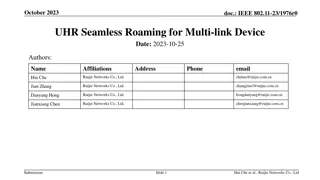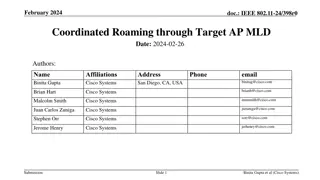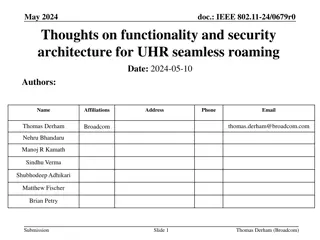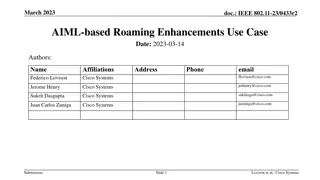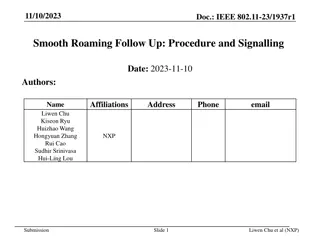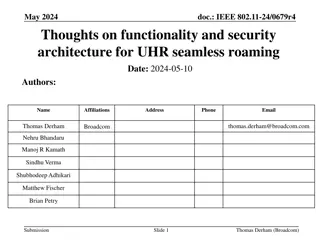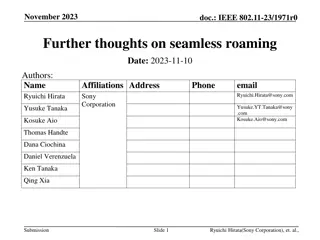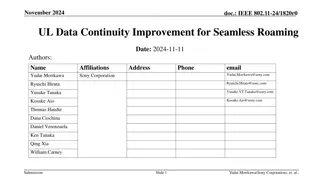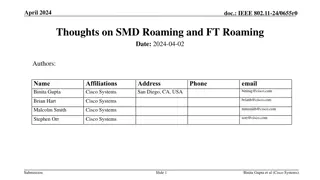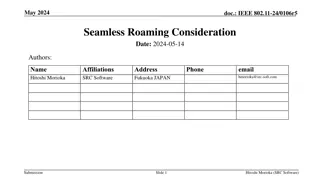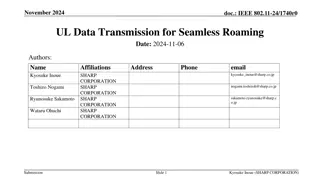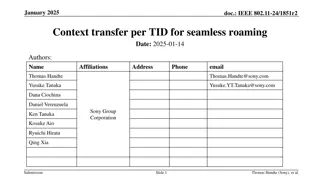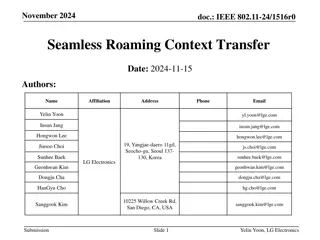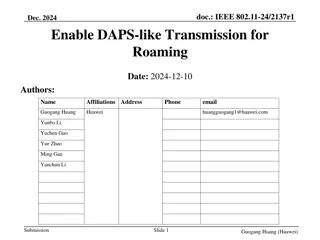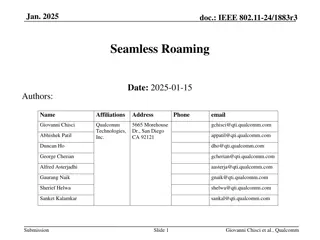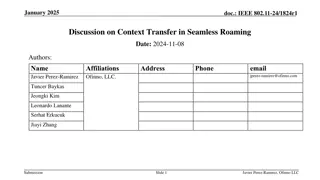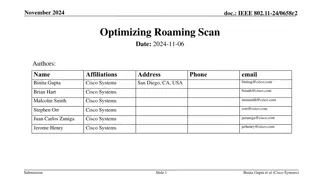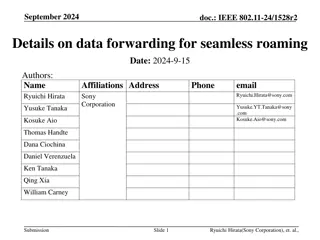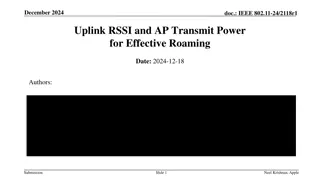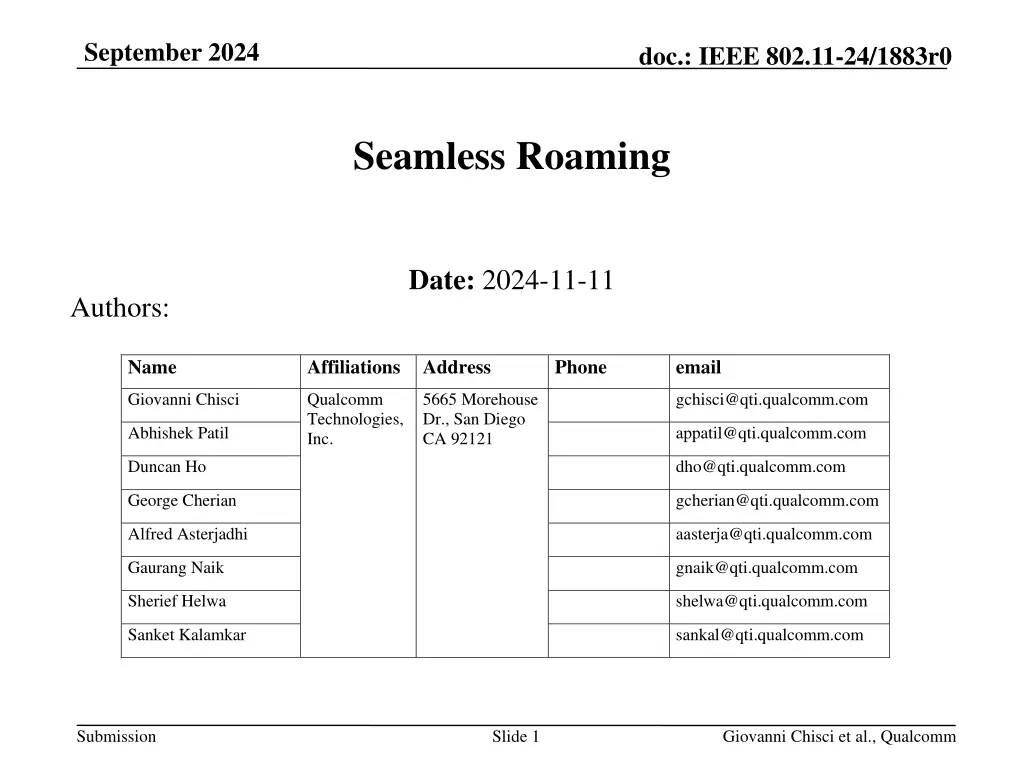
IEEE 802.11-24/1883r0 Seamless Roaming Protocol Overview
Discover the latest developments in IEEE 802.11-24/1883r0 Seamless Roaming protocol, designed to enhance mobility and connectivity in wireless networks. Learn about the requirements, key aspects, and implications of this innovative technology for seamless transitions between access points. Stay updated on the advancements in networking protocols for a more efficient and reliable user experience.
Download Presentation

Please find below an Image/Link to download the presentation.
The content on the website is provided AS IS for your information and personal use only. It may not be sold, licensed, or shared on other websites without obtaining consent from the author. If you encounter any issues during the download, it is possible that the publisher has removed the file from their server.
You are allowed to download the files provided on this website for personal or commercial use, subject to the condition that they are used lawfully. All files are the property of their respective owners.
The content on the website is provided AS IS for your information and personal use only. It may not be sold, licensed, or shared on other websites without obtaining consent from the author.
E N D
Presentation Transcript
September 2024 doc.: IEEE 802.11-24/1883r0 Seamless Roaming Date: 2024-11-11 Authors: Name Affiliations Address Phone email Giovanni Chisci Qualcomm Technologies, Inc. 5665 Morehouse Dr., San Diego CA 92121 gchisci@qti.qualcomm.com Abhishek Patil appatil@qti.qualcomm.com Duncan Ho dho@qti.qualcomm.com George Cherian gcherian@qti.qualcomm.com Alfred Asterjadhi aasterja@qti.qualcomm.com Gaurang Naik gnaik@qti.qualcomm.com Sherief Helwa shelwa@qti.qualcomm.com Sanket Kalamkar sankal@qti.qualcomm.com Submission Slide 1 Giovanni Chisci et al., Qualcomm
September 2024 doc.: IEEE 802.11-24/1883r0 Introduction TGbn has agreed to specify a new mechanism [Jan 2024] for seamless roaming of a non-AP MLD from a current AP MLD to a target AP MLD with the following characteristics: [Jul 2024] Context related to the non-AP MLD can be (at least partially) transferred from the current to the target AP MLD [Jul 2024] After a request/response exchange initiating the DS mapping change, buffered DL data can be: Delivered by the current AP MLD retrieved by the non-AP MLD on the old link Forwarded from the current AP MLD to the target AP MLD so that the non-AP MLD may retrieve it on the new link [Sept 2024] A request/response exchange is defined from a non-AP MLD in state 4 to Transfer the context Perform necessary DS mapping change Submission Slide 2 Giovanni Chisci et al., Qualcomm
September 2024 doc.: IEEE 802.11-24/1883r0 Seamless Roaming requirements Should be seamless No disruption to on-going QoS flows Avoid unnecessary overhead (reduce frame exchange/processing) Reliable roaming (can be prepared in advance and correct expectations are set for clients) Should be scalable To support mobility within a network consisting of large number of APs Should be simple E.g., Rely on existing frameworks as much as possible Should be flexible To cover different use cases such as home, enterprise, warehouse, etc. Submission Slide 3 Giovanni Chisci et al., Qualcomm
September 2024 Seamless Roaming Mobility Domain (SRMD) doc.: IEEE 802.11-24/1883r0 To fulfill the requirements of Seamless Roaming (SR), one of the key aspects is to identify the group of AP MLDs over which the SR protocol can be used. A Seamless Roaming Mobility Domain (SRMD) shall be defined and identified with a unique identifier (SRMD ID) to facilitate the operations involved in the transition between a current AP MLD and a target AP MLD belonging to the same SRMD can be carried while referring to such an SRMD ID, for example: Discovery of the AP MLDs within the SRMD across which the non-AP MLD can seamlessly roam Security Consistency of BA operation Set up links While SR can provide the most seamless experience within the SRMD, it is expected mobility in larger ecosystems (e.g., between SRMDs) can be aided by fast BSS transition (FT). FT MD SR AP MLD 2 AP MLD 1 SRMD 1 SRMD 2 AP MLD 4 SRMD 3 FT AP MLD 3 Submission Slide 4 Giovanni Chisci et al., Qualcomm
September 2024 doc.: IEEE 802.11-24/1883r0 Seamless Roaming In Steps To deliver a smooth experience, Seamless Roaming extends over different steps: Discovery: the client discovers the neighboring AP MLDs in the SRMD Preparation: the client can receive recommendations on suitable candidate AP MLDs in the SRMD that can meet the client s requirements E.g., considering client s context, loading conditions, check on the backhaul, etc. BTM signaling can be considered, e.g.: BTM query/request solicited BTM request unsolicited Setup: the client requests the current AP MLD to set up a target AP MLD in the SMRD over the backhaul Set up of the links First instance of context transfer Signaling for the client/current AP MLD request/response exchange is TBD (e.g., ML reconfiguration) Combination with the Preparation step can be considered Transition: the client request to roam to the target AP MLD in the SMRD Second instance of context transfer Necessary DS mapping switch Both exchange client-current and client-target AP MLD can be considered (current in the figure) Accepted if request is received within a timeout after Setup completion Client AP MLD0 AP MLD1 AP MLD2 Discovery/Scanning Preparation Setup Request AP MLD 1 Set up links context transfer (1) Setup Response Setup timeout (Transition request is accepted if performed within timeout after Setup completion) Transition request AP MLD 1 context transfer (2) Necessary DS map switch Transition Response Submission Slide 5 Giovanni Chisci et al., Qualcomm
September 2024 doc.: IEEE 802.11-24/1883r0 Discussion on the Roaming Setup Some of the key operations for SR that are expected are Context transfer Link set up Such operations are expected to require some latency (e.g., some tens of ms), therefore it is preferable to avoid service disruption (e.g., interruption of DL/UL communications) while such operations are carried out. Propose to decouple the request/response exchange for the roaming transition (which can involve DS mapping switch and therefore service interruption) by introducing a link setup step in the SR sequence. The context transfer can initiate at this time. It can be further considered that after the Setup is performed, the current AP MLD shall accept the Transition request at least if received within a timeout after Setup completion, in this way the expectation is set for successful roaming transition. Submission Slide 6 Giovanni Chisci et al., Qualcomm
September 2024 doc.: IEEE 802.11-24/1883r0 Conclusion A Seamless Roaming Mobility Domain (SMRD) is introduced and identified by a unique identifier A client can use the SR protocol between the AP MLDs within the SMRD The SR protocol develops in steps including: Discovery: AP MLDs within the SMRD Preparation: network recommendation for candidate AP MLDs Setup: set up the links and transfer the context to the target AP MLD Transition: context transfer and necessary DS mapping switch Submission Slide 7 Giovanni Chisci et al., Qualcomm
September 2024 doc.: IEEE 802.11-24/1883r0 SP1 Do you agree to define a seamless roaming mobility domain, characterized by an identifier, encompassing multiple AP MLDs, where a non-AP MLD can use the seamless roaming procedure to roam between such AP MLDs. Submission Slide 8 Giovanni Chisci et al., Qualcomm
September 2024 doc.: IEEE 802.11-24/1883r0 SP2 Do you agree to define in 11bn a mechanism so that in seamless roaming, before the request/response message for requesting the transition of the non-AP MLD from the current AP MLD to the target AP MLD: Context can be transferred to the target AP MLD Links are set up with the target AP MLD Submission Slide 9 Giovanni Chisci et al., Qualcomm
September 2024 doc.: IEEE 802.11-24/1883r0 THANK YOU Submission Slide 10 Giovanni Chisci et al., Qualcomm

